The history of motor cars has thrown up some strange designs; so far the Museum of RetroTech has barely dipped its institutional toe into a vast subject. Almost all designs, however, no matter how weird or misconceived, had one thing in common- they were propelled by applying torque to the wheels that supported them. Not these machines, though. They were pulled (or more often pushed) along by a propellor.
An obvious objection to the concept is the loss of efficiency due to the propellor drive system. A conventional car has an effectively solid connection between engine and road, though there are inevitably some small losses in the gearing and the hysteresis of the tyre rubber. Propellers are very inefficient working much below their design speed, ie the natural advance ratio. (sort of how the propeller would move forward if it was working in jelly) Efficiency drops fast, to below 20% when you are going at 20% of the design speed. This is why prop-cars have the universal disadvantage of really poor acceleration from a standing start.
I imagine a variable-pitch propeller would help with this to some extent, but it would not be a complete cure. Variable-pitch propellers are a relatively advanced technology, beyond the reach of most amateur inventors. The only known examples at present are the Spencer Heath prop-test waggon and the Maybach prop-car.
One (probably the only) advantage of propellor traction is that a slippery road surface does not affect propulsion; however, since friction between wheels and road is still required for braking and steering, this might not be very useful.
The propellor-driven road vehicles in The Museum have been divided into: two-wheeled vehicles with propellors powered by pedal, two-wheeled vehicles with propellors powered by an IC engine, and three or more wheeled vehicles with propellors powered by an IC engine.
A recurring theme on this page is various vehicles all called 'Wind-Wagon'. Many of them were for propellor research and were in no way intended to challenge conventional cars.
For some non-road propellor-driven vehicles, see Propellor-Driven Locomotives and Propeller-Driven Sleighs.
THE CURTISS WIND WAGON: 1906
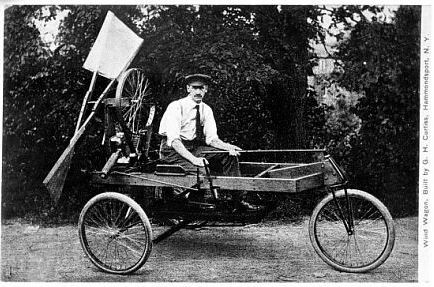 |
| Left: The Curtiss Wind-Wagon: circa 1906
Glenn Curtiss sits in one of his Wind Wagons, used by Thomas Scott Baldwin to test Curtiss airship propellers for Baldwins airships.
Note the twin arms joined at the end by what look like fabric 'propellor blades'. The picture quality is poor but there appears to be a V-twin engine driving the propellor via a wide belt and with a considerable reduction ratio.
This is the earliest propellor wagon found so far. It is not likely that an earlier machine will be found as 1906 is very early in the development of the IC engine. Did no-one make a steam-powered propcar? None found so far.
|
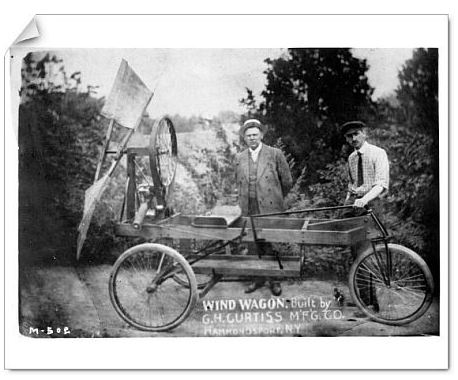 |
| Left: The Curtiss Wind-Wagon: circa 1906
Curtiss himself said:
“‘The machine, although of no commercial value, is thoroughly practical and will easily run at the speed mentioned, 30 miles per hour…
‘It is needless to say that the rig is a great horse scarer, and blows up a great cloud of dust when passing along the road, and will even pull the leaves from the trees where the branches are low.’
…There is no patent on the idea and any of our readers who have a small gasoline motor can build their own craft from the suggestions given in the illustrations."
A thoroughly practical assessment from Mr Curtis.
|
DR THOMAS' WIND-WAGON: 1909
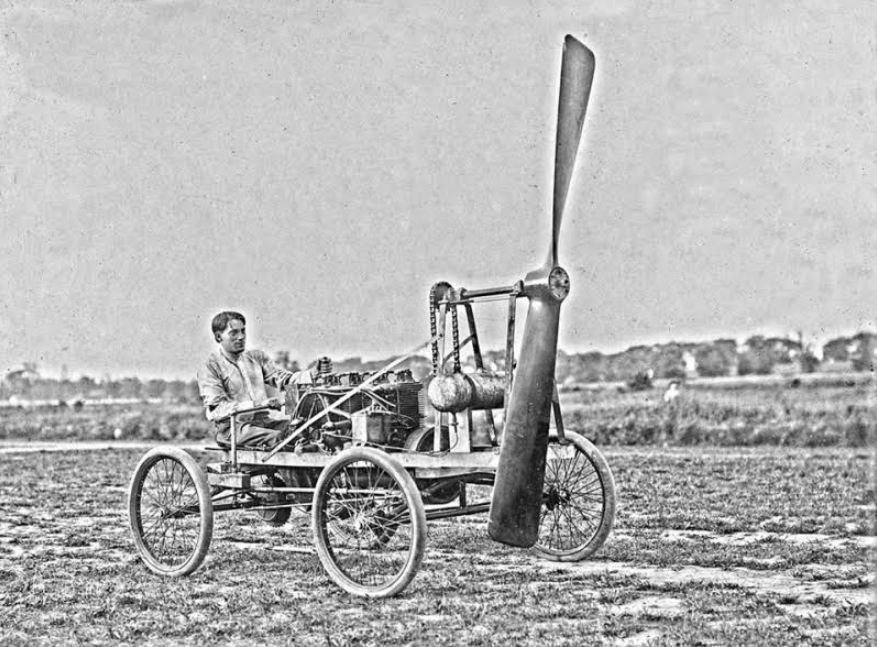 |
| Left: Doctor Thomas' wind-wagon: 1909
This four-wheel propcar was designed by Doctor Julian P Thomas and driven here by Charles M Crout, as part of some kind of competition. There was supposed to be a race with another car, (It is not known if this was also a prop-car) but the other driver was seriously injured when the front wheels of his car collapsed making a turn.
The prop-car was said to have given "a surprising demonstration of speed". Judging by the look of the chain drive, the prop was not geared down much if at all.
It appears that Doctor Thomas had Previous; he had earlier built a car with a rear propeller that was driven along a crowded street, which must have been rather hazardous. It was not popular because of the noise it made and the clouds of dust thrown up.
Location: Morris Park, in the Bronx, on June 1909
There is more info on Doctor Thomas here; he seems to have been a bit of a nutter, performing some dangerous balloon flights. Charles M Crout appears to be unknown to Google.
|
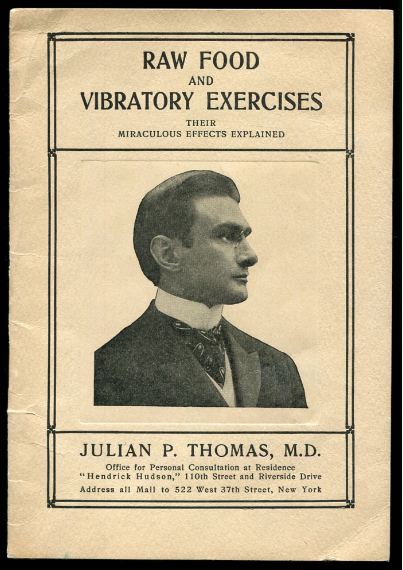 |
| Left: Portrait of Doctor Julian P Thomas: 1910?
Here is Dr Thomas. He did not confine his interests to balloons and wind-wagons. Apparently "Includes ads for the doctor's rectal suppositories".
Tests of the wind-wagons did not get off to a good start. This is from the Urbana Daily Courier, for 3rd November 1908:
"Dr Julian P Thomas Badly Hurt"
"New York, Nov 2nd. While experimenting late Sunday with his wind wagon, Dr Julian P Thomas, the aeronaut, met with an accident at the Morris park experiment grounds of the Aeronautic society. Dr Thomas was carried to the cluhroom unconscions. The physicians who were called decided that he had suffered no internal injuries, but still feared that serious spinal trouble would result."
|
Dr Julian P Thomas makes the papers again; this is from the New York Times for 25 March 1909, Page 7:
SUING DR. THOMAS FOR HER AUTO RIDE; Miss Haas's $25,000 Damage Suit for Loss of Her Leg on Trial. CAR HIT A TROLLEY POLE And Everybody Was Hurt -- Dr. Thomas and Girl's Companion Are Suing the City.
Dr. Julian P. Thomas, known to fame both as an aeronaut and automobilist, appeared yesterday as defendant before Supreme Court Justice Brady and a jury in the action in which Miss Frances Haas seeks to recover from him $25,000 damages for the loss of her right leg in the automobile accident on the night of July 7, 1907, in which both were injured.
|
The Museum Staff have not so far been able to discover the outcome of the case.
It seems that Doctor Julian P Thomas was a man best avoided.
|
UNIDENTIFIED PROPELLOR TRICYCLE: 1910?
 |
| Left: Unidentified propellor tricycle: 1910?
This three-wheeler is of unknown origin. The propellor is run at a lower speed than the engine by means of a belt and pulleys.
An image search has yielded nothing.
|
UNKNOWN GERMAN PROPELLOR TRICYCLE: 1910?
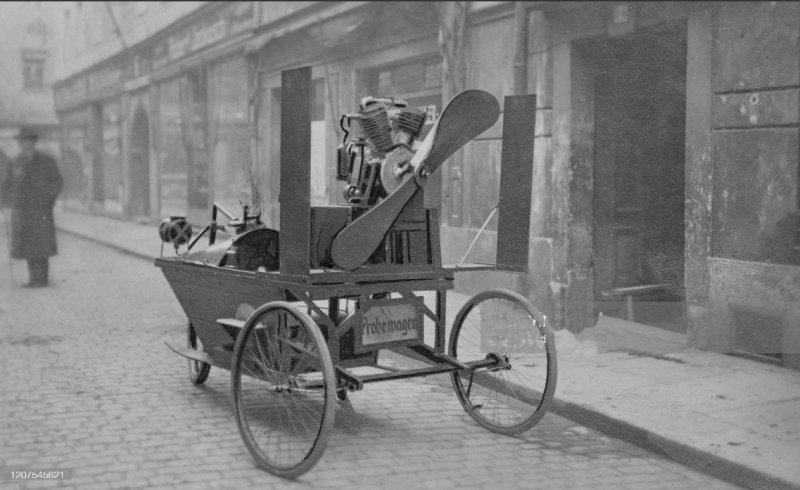 |
| Left: Unknown German propellor tricycle: 1910?
This three-wheeled machine is currently mysterious. It is certainly German (or possibly Austrian) because the sign on the back says probewagen, ie 'test-car' in Fraktur script. The design of the engine suggests around 1910. It is a V-2, driving the propellor directly.
The two boards either side of the propellor are presumably a rudimentary prop-guard; I am not impressed.
A reverse image-search with Google reveals nothing.
|

OVERLAND PROPELLOR CAR: 1910
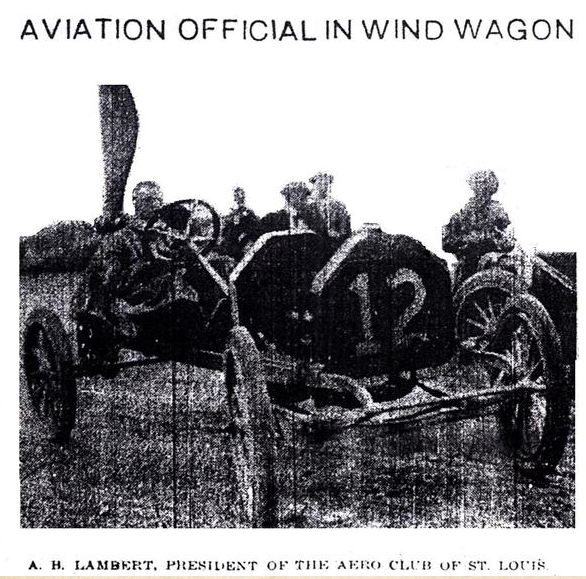 |
| Left: Overland propellor car: 1910
This propcar (a modified Overland) appeared at the Indianapolis Motor Speedway during the the June 1910 aviation meeting. It was built by Overland for promotional purpose. It had an 8-foot diameter propellor and was reported to have reached 53 mph.
Once again, an early use of the phrase 'Wind-Wagon'.
More info here.
Apologies for poor picture quality.
|
 |
| Left: Overland propellor car: 1910
This is a better version of the above picture, but with the spectators in the background retouched out.
|
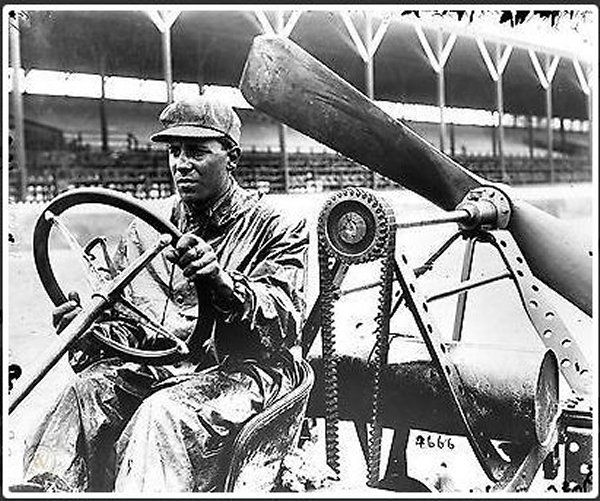 |
| Left: Overland propellor car: 1910
Presumably this photo was taken at the Indianapolis Motor Speedway. The propellor is different.
The driver does not look confident.
|


THE ABC PROPELLOR CAR: 1911
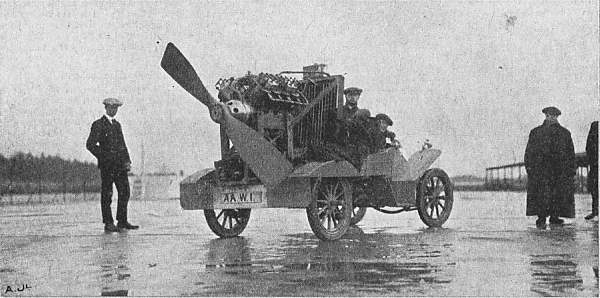 |
| Left: The ABC propellor test car: 1911
This car was built, not as a transportation device in its own right, but to test aeroplane propellors. The one shown was designed by a Mr Lang, seen here seated beside the driver, Mr Charteris. It is shown here at the Brooklands motor circuit, having driven there from Southampton by propeller-power only in the early hours of the morning, a time no doubt chosen to minimise the number of other road users minced by the wholly unguarded propellor. It is hard to see how that can have been been legal.
Fom Flight 27 May 1911
|
The engine is an 80 HP V-8 with open valvegear built by the All-British Engine Company. Just in front of it is a large radiator. On the trip up from Southampton the engine was run at 900 rpm, giving a propeller thrust of about 330 pounds.
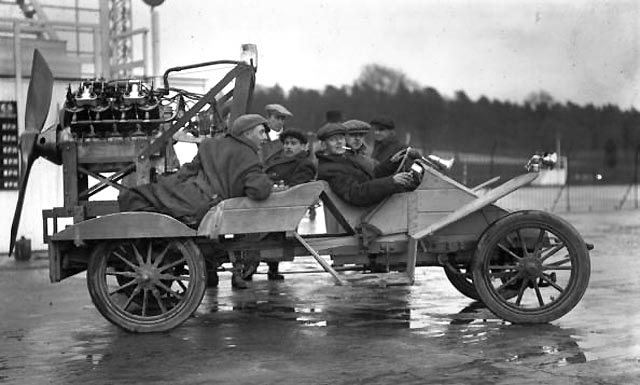 |
| Left: The ABC propellor test car: 1911
This is obviously the same machine as above. It is shown here after arriving at Brooklands.
It looks as though two people sat in the front, and two in the back, one each side of the radiator, and precariously close to that big unguarded propellor.
|


THE AUTO-AERO PROP-CAR
 |
| Left: Auto-aero prop-car: 1912
This machine was designed by Count Bertrand de Lesseps, a son of Ferdinand de Lesseps, who developed the Suez canal. He stands here on borrowed time; he was killed in the First World War.
The lugubrious chap to the left of the car appears to be holding a spare propellor.
Objections were that the acceleration was leisurely, there was no engine braking, and the noise level was too high; objections applicable to all prop-cars. Not to mention the horrible danger from that vestigially-guarded propellor.
|


THE CROS FRENCH ARMY PROP-CAR SAUTERELLE
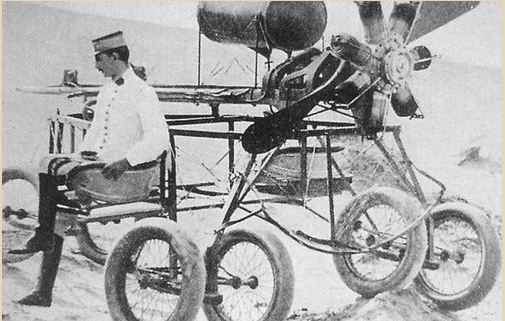 |
| Left: Cros French Army prop-car: 1912
This propcar was invented by Corporal Gustave Cros; it was intended for crossing the sandy deserts that made up much of France's north African colonies. Sauterelle is the French word for grasshopper, and it appears the machine proceeded in a series of jumps, which supposedly allowed it to cross sand dunes. If that is true, it does not seem a sound way of proceeding.
Features include an unusual 6-wheel configuration, with the four back wheels in tiltable pairs, presumably to aid crossing rough ground, and two bucket seats on outriggers.
The seven-cylinder engine at first looks a bit inscrutable, having the propellor apparently fitted on the wrong side of the engine. The explanation is almost certainly that it is a rotary engine, in which the engine and propellor go round together, but the crankshaft is rigidly fixed to the chassis; the date fits in with the period of popularity of rotary engines. They were later dropped because of their inherent limitations.
Source: unknown
|
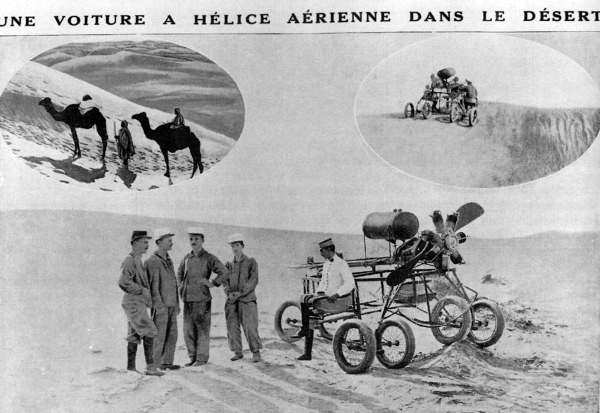 |
| Left: Cros French Army prop-car: 1912
A larger version of the picture above. A mound of sand has been built to demonstrate the flexibility of the rear wheel arrangement.
Source: unknown
|
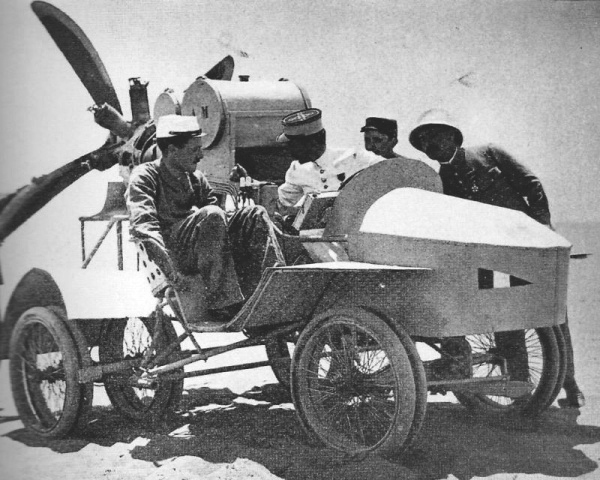 |
| Left: Cros French Army prop-car: 1912
This version of the Cros propcar has gained a rudimentary body, and a four-bladed propellor mounted more conventionally on the engine.
It also appear that each tyre has been doubled, giving a total of 12 wheels on the sand.
|
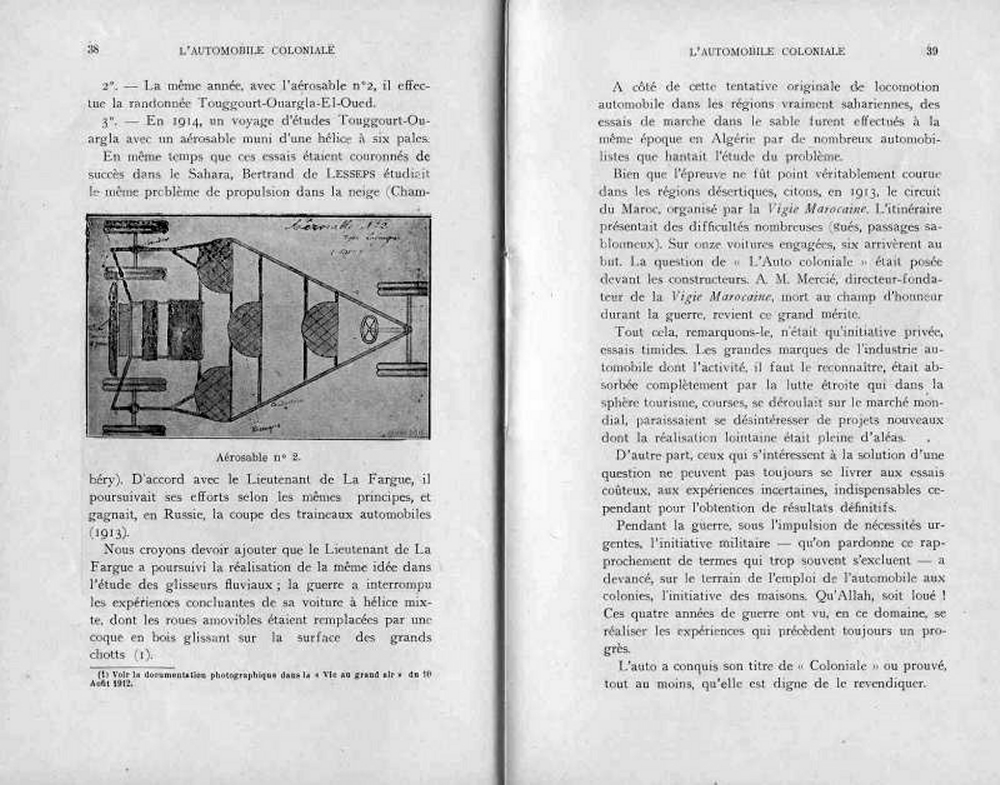 |
| Left: French Army prop-cars: 1914
This extract from L'Automobile Coloniale gives a plan view of the Cros propcar, and also mentions the machine of Lieutenant La Fargue, with its six-bladed propellor; see it in the next section.
Source: L'Automobile Coloniale: and Stories of Raids Automobile Saharien. |
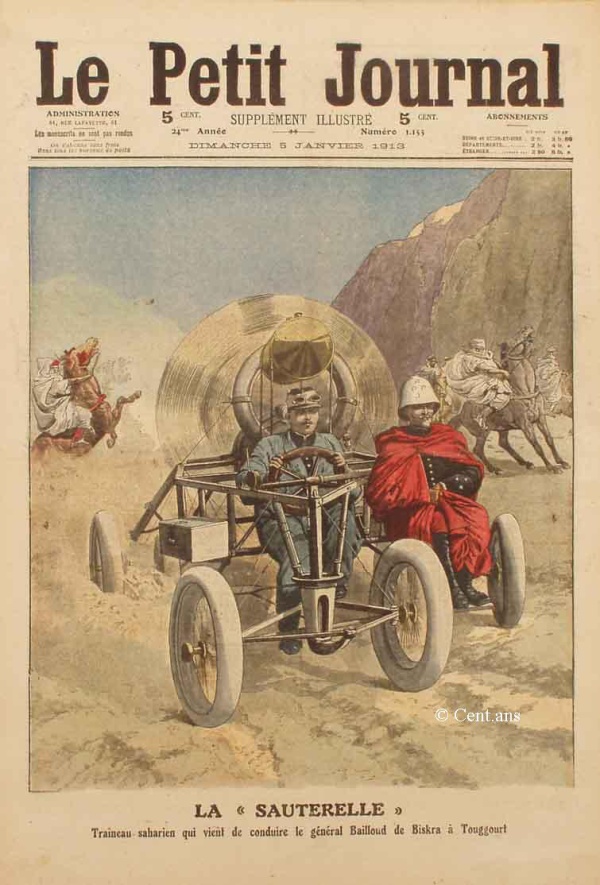 |
| Left: Cros French Army prop-car: 1913
The caption says General Bailloud is being rushed from Biskra to Toggoroui. The only candidate found is General Maurice Bailloud, who was stationed in Algeria from 1902 to 1906; he retired from the army in 1912. Perhaps he was keeping up an interest in colonial transport in retirement.
The locals are not impressed.
Sauterelle means "grasshopper".
Source: Le Petit Journal 5 January 1913
|
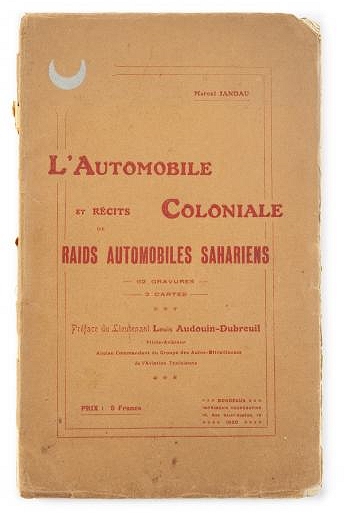 |
| Left: The cover of L'Automobile Coloniale: 19??
Marcel Jandau has his name on the front and was presumably the author; he is unknown to Google. Date of publication unknown.
This is believed to come from L'Automobile Coloniale:
“We left Biskra with Corporal Dewoitine as a mechanic, and took hours to reach Touggourt, averaging 50kph, despite a trail of frightful ruts. Our arrival was all the more sensational than in an airplane because I drove right down the main street in a torrent of dust, skimming past walls and passers-by with with my propeller, causing burnous, guenours and chèches to fly in all directions. It was a beautiful panic!"
"The two adventurers quickly left Touggourt in a cloud of dust, heading for Ouargla, but the infernal locust began to show its first signs of fatigue: sand gnawed the leading edge of the propeller and the engine dropped to half power. De La Fargue ordered Dewoitine to head for Square Bresson, a junction and small oasis 50km away.”
|

UNKNOWN PROP-CAR
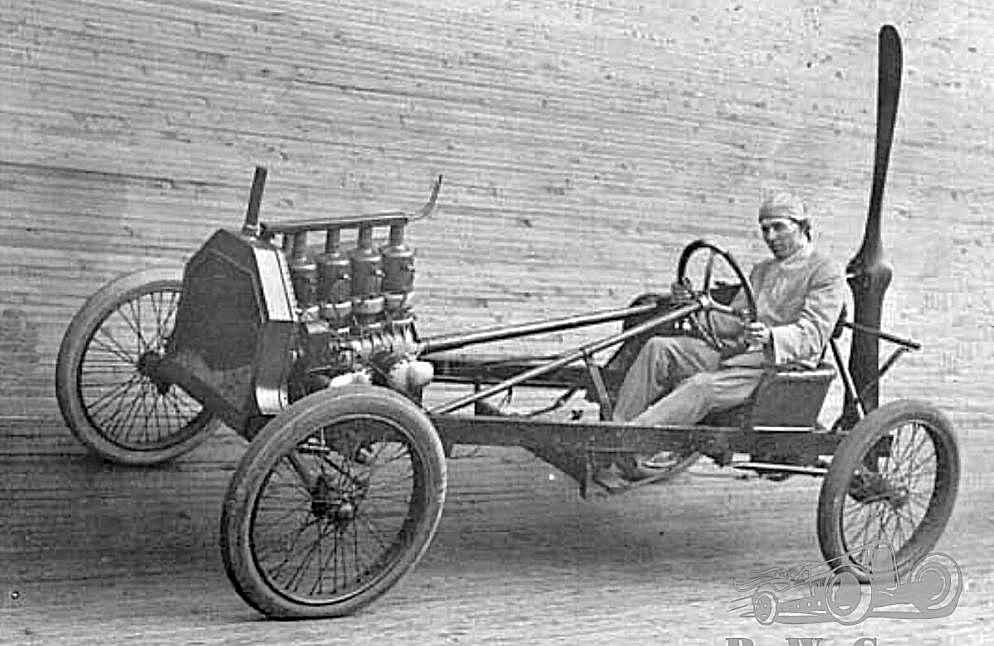 |
| Left: An Unknown prop-car: 19??
This image was Found On The Net. The photograph was taken on a boardtrack circuit in Newark, New Jersey in 1910. Since the two-blade propellor seems to be driven directly from the crankshaft with no reduction gear, efficiency would have been low.
Don't lean back too far.
Can anyone identify the car from its radiator?
|

UNKNOWN PROP-CAR
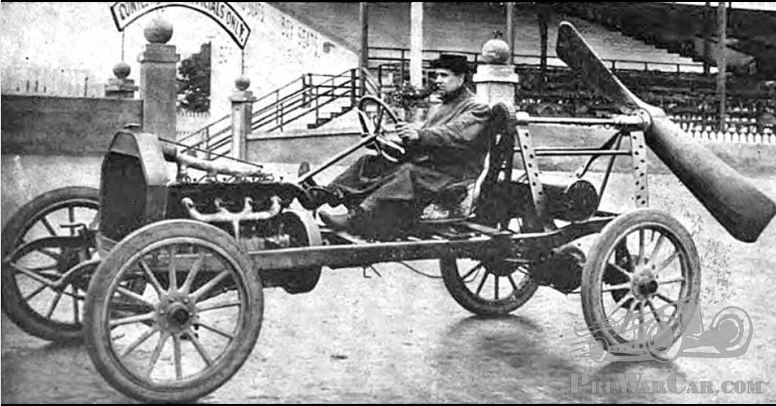 |
| Left: Another Unknown prop-car: 19??
This looks even more dangerous to the driver. He seems to be resting his shoulder on the propellor drive pulley. Looks like there is some gearing-down of the prop.
Nothing else known at present, but the car seems to have the steering wheel on the right, and so is probably British.
|

AN ENGLISH PROP-CAR
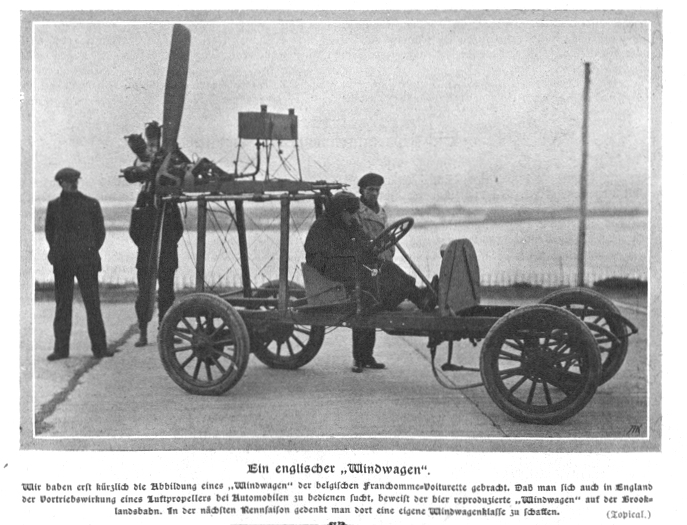 |
| Left: An English prop-car: 1912
You can see here that the radial engine is outside the two-bladed propellor. It is clearly a rotary engine, which goes around with the propellor while the crankshaft remains stationary. So far this is the only prop-car discovered that used a rotary engine.
Four cylinders of the engine are visible, suggesting it was a seven-cylinder design. The most famous rotary engine was the Gnome Monosoupape engine; but that was not introduced until 1913.
Note the gravity fuel tank and the extensive use of wire bracing, as was used in aeroplanes of the era. Probably this was done in an attempt to save weight; note that some of the wires are slack and not doing anything.
No other information is currently available.
Source: Publication Feb 1912
|
 |
| Left: An English prop-car: 1912
This is a translation of the caption above. It says that the picture was taken at Broolands racing circuit, which may allow the machine to be identified.
|

THE LAFARGUE FRENCH ARMY PROP-CAR
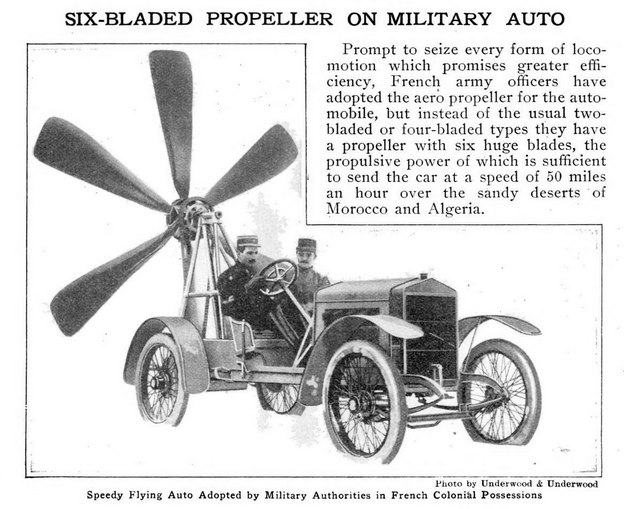 |
| Left: French Army prop-car: 1914
This adaption was intended for easy travel over sand in the French African colonies. It had a truly enormous unguarded propellor; just reversing towards the enemy should frighten them off. But I see no sign of reversible-pitch propellor blades so going backwards was presumably not possible- unless of course the conventional drive to rear wheels was retained.
Its practicality is highly doubtful; it would raise an enormous cloud of dust behind it which would make it impossible for another vehicle to follow it. The dust cloud would also give away its position. Something like a sandworm.
This machine was built by a Lieutenant La Fargue.
|
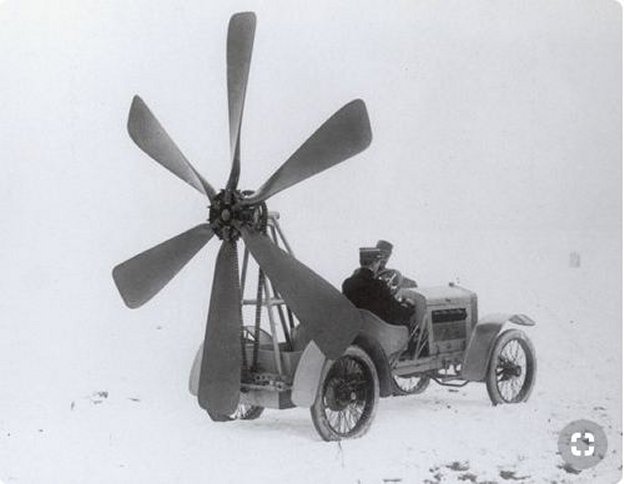 |
| Left: French Army prop-car: 1914
I think this wins the 'largest propellor on a prop-car' award.
Clearly taken on the same occasion as the photo just above.
|

THE GARBACCIO PROP-CAR
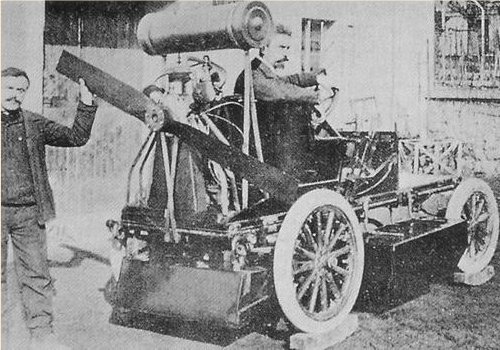 |
| Left: Garbaccio prop-car: 1915
This appears to be one of the very few amphibous prop cars. Floatation tanks are attached at the rear and the sides.
François Garbaccio, from the canton of Valais in southern Switzerland, built it from 1908 - 1915 in Sierre, Switzerland.
The propeller was about 2 meters in diameter. The vehicle was intended to achieve 100 km/hr on land and 50 km/hr on water; it is highly unlikely it managed either. It remained a prototype. The engine is a V-3 of unknown make; John Sullivan suggests it is probably an Anzani 3-cylinder fan engine; see
Wikipedia.
|

THE SIZAIRE-BERWICK WIND WAGON
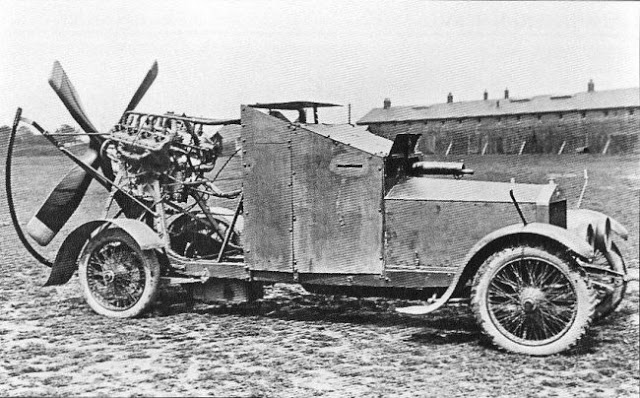 |
| Left: Sizaire-Berwick Wind Wagon: 1915
The "Wind Wagon" was a 1915 conversion of a Sizaire-Berwick car. It was a British Admiralty experiment, that like the French Army prop-car above, was intended to solve traction problems on sand in Africa and the Near East. Only one prototype was made, and it was only ever tested in England, which seems to indicate the results were not promising.
A 110hp Sunbeam aircraft engine was installed, angled to give some down-thrust. The 'armor' was ordinary steel plate. There was room for 2 crew members and it carried a 0.303 calibre Vickers machine gun. Length was 170", width 67", height 78", and the weight about 8800 lbs. This appears to be the only photograph in existence.
Sizaire-Berwick was an Anglo-French car manufacturer active between 1913 and 1927.
There are instructions on modelling the Wind-Wagon on YouTube.
|
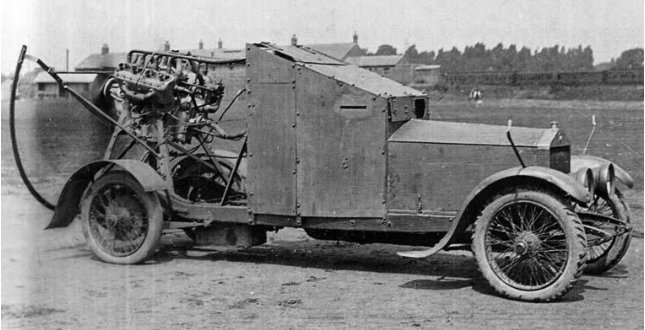 |
| Left: Sizaire-Berwick Wind Wagon: 1915
OK, not the only photograph in existence. This appears to be at almost the same location. (judging by the spacing of the chimney-pots behind) This time the propellor is spinning and the flap on the rear compartment has been lowered.
|

THE HACHOIR TRICYCLE
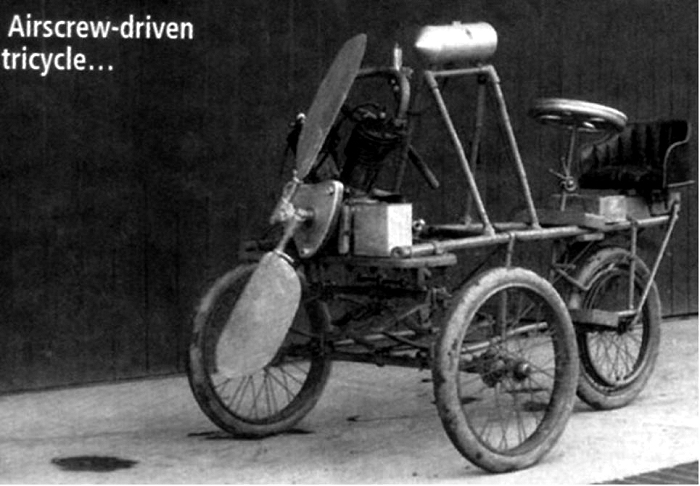 |
| Left: The Hachoir Tricycle: 19??
Very little is known about this machine, which was apparently called 'The Hachoir' which is french for 'chopper', and is doubtless a reference to the unguarded propellor. The V2 twin engine is believed to have been a Poinsard, but according to Wikipedia Poinsard seems to have made only horizontally-opposed twins. There is some evidence the name Jones was associated with it. Can anyone add more information?
Note the stub exhaust pipes- this machine would have been noisy as well as dangerous. At least you would have heard it coming.
There is a little info here.
Thanks to Steven McDonald for drawing this machine to my attention.
|

THE HELICA
The Helica was invented, developed, and manufactured by the Frenchman Marcel Leyat, between 1913 and 1926. Thirty are said to have been built, though I am not at present sure if this includes prototypes, of which there were several; only a few are shown here. Certainly some were built for sale, and two of these survive.
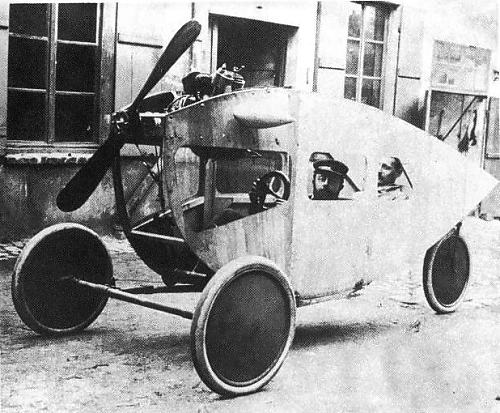 |
| Left: A early Helica: 1913 design.
This is a three-wheeled two-seater. Note the complete absence of any guard for the propellor; it is difficult to believe this would have been street-legal.
The engine appears to be a V-twin.
|
 |
| Left: An Helica: 1914 model, called "The Helicocycle" .
This model has gained a wooden shroud around the propellor, presumably for safety reasons. I Am Not An Aerodynamicist, but it looks too short to give a ducted-fan effect, which would have improved propulsion efficiency over an open propellor.
There also appears to be a wire guard over the front of the propellor, which is again two-bladed in this version.
Still a three-wheeler.
|
Only two Helicas survive. Here they are:
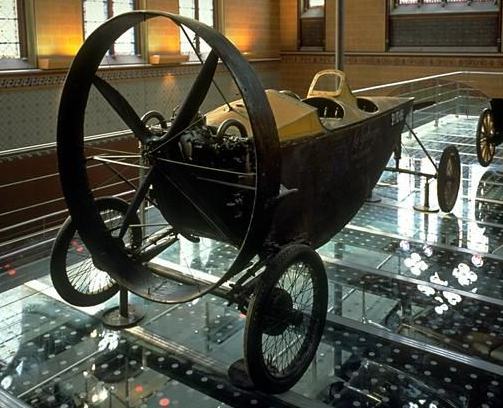 |
| Left: A surviving Helica in CNAM: 1921 model.
This four wheeled Helica belonged to Gustave Courau. It was donated to the CNAM Museum in Paris in 1931, and is still on show there. CNAM is the Conservatoire National des Arts et Metiers, a very fine museum frequented by concept car enthusiasts, overall Parts Geek admirers and even just the casual car lover.
Note the propellor is now four bladed, possibly to reduce noise and vibration. According to the notice attached by the museum, this Helica was capable of "rapidly achieving a good 70 kph" but this is only 43 mph, unimpressive even for its day.
The notice also says that the Helica did not succeed because the propellor wash was too uncomfortable for the occupants. Since even the versions with a roof seem to lack a windscreen, this was almost certainly a contributing factor; however what killed it off was the general impractability of the whole concept.
|
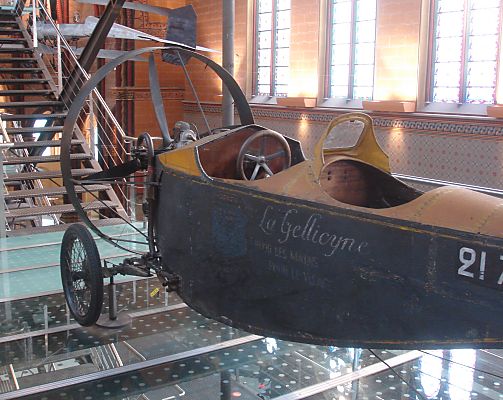 |
| Left: A surviving Helica in CNAM: 1921 model.
Another view. The passenger gets a rudimentary windscreen, but not the driver.
Note "La Gellicyne" is written on the side. For a long time its meaning was obscure, but one of my correspondents informs me it's an advetisement for a brand of cosmetic cream. Computer enhancement shows "Pour les mains. Pour
le visage" ("For the Hands. For the Face") in very faded lettering below "La Gellicyne" .
|
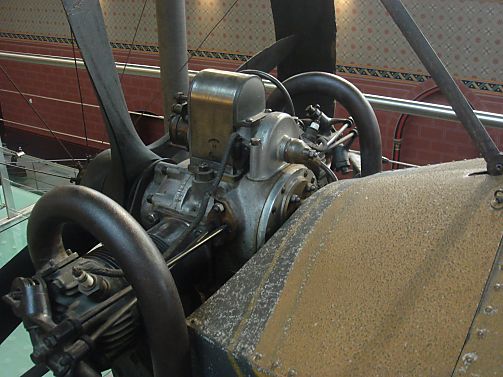 |
| Left: A surviving Helica in CNAM: 1921 model.
The engine. I could not see any maker's name. It is an air-cooled horizontally opposed twin, with pushrod valves and magneto ignition. The propellor is directly-driven.
The two curved pipes direct the exhaust to the underside of the Helica.
|
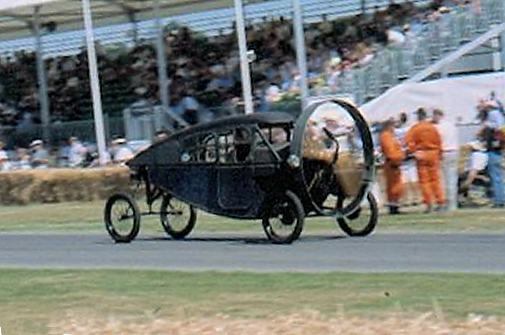 |
| Left: The only running Helica, seen under power at Goodwood racetrack (Britain) in July 2003.
This Helica is owned by Jean Francois Bouzanquet of Paris. It was bought new by his grandfather in 1922, and it has been in the family ever since.
The engine is a British two-cylinder ABC of 1203 cc, driving a 4.5 foot diameter wooden propeller; maximum speed is about 60mph, which is a good deal faster than the Helica in CNAM.
|
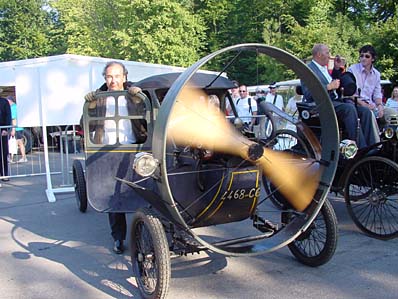 |
| Left: The only running Helica at Goodwood in July 2003.
The steering wheel operates the rear wheels by wires, which can, according to the owner, be 'interesting'.
|
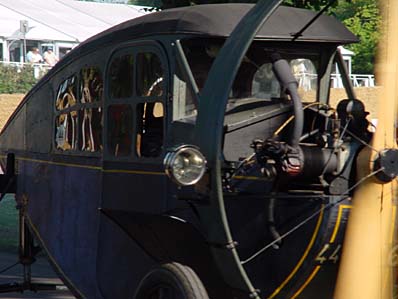 |
| Left: The only running Helica at Goodwood in July 2003.
The Bouzanquet Helica is said to be in original condition except for a replacement propeller. In WW2 the German forces attempted to commandeer the vehicle. Confused by the steering system, the driver turned right instead of left, hitting a tree and breaking the propeller.
The exhaust silencing arrangements look rather rudimentary.
|
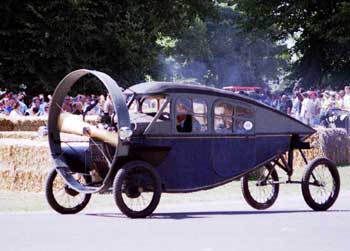 |
| Left: The only running Helica at Goodwood in July 2003.
The replacement propellor is two-bladed.
|
There is a YouTube video of a Helica allegedly dating from 1924. The model however most closely matches the 1914 model pictured above.
Many thanks to Paul Dunlop for drawing my attention to this remarkable series of machines, and special thanks to Claude Guéniffey for permission to use images from his superb website- the home of Helicas- at http://www.helica.info/

SPENCER HEATH TEST PROP-WAGON
 |
| Left: Unidentified prop-driven vehicle: 1922
This machine has been a mystery for a long time, so I have decided to leave the text accompanying this first picture unchanged.
This photograph commonly appears when you Google 'propeller-car' or similiar. However no information is ever attached apart from the date 1922. Any assistance on identification would be much appreciated by the Museum staff.
Here we see a big 2-bladed propellor mounted on something like a heavy farm wagon, and driven by a water-cooled V-8 engine. A small radiator is perched above the engine. The tank on stilts at the back is probably a gravity-feed petrol tank.
Here is all that is known: the photograph comes from the Library of Congress‘s photo archive, which describes it simply as a “wheeled vehicle with mounted propeller” and dates it to 11 October 1922. Someone called Herbert A French (unknown to Google) donated the photo to the library in 1947. The overhead-camshaft V-8 engine appears to be a World War I Hispano-Suiza aircraft engine.
What purpose this machine was built for is currently obscure, but looking at the unusual way the propellor blades are mounted to the hub, it might be an experiment in varying blade pitch.
Thanks to Pavel Panenka and John Sullivan for their contributions.
|
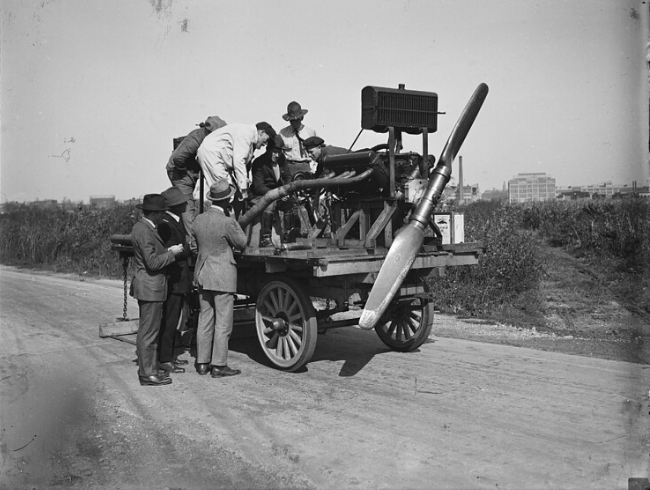 |
| Left: Identified Spencer Heath prop-driven vehicle: 1922
This proved to be a test vehicle for the 'Paragon' variable-pitch (including reverse) aircraft propeller invented by Spencer Heath, who was clearly a remarkable man. It was tested on 11 October 1922 at Bolling Field, Washington DC.
Spencer Heath founded the American Propeller Manufacturing Company in 1909, developing, and mass-producing for the first time, airplane propellers. He made 70% of the propellers used by the USA in WW1.
Thanks to Paul Dunlop for locating this picture on Flickr.
|

THE MARATUECH PROP-CAR?
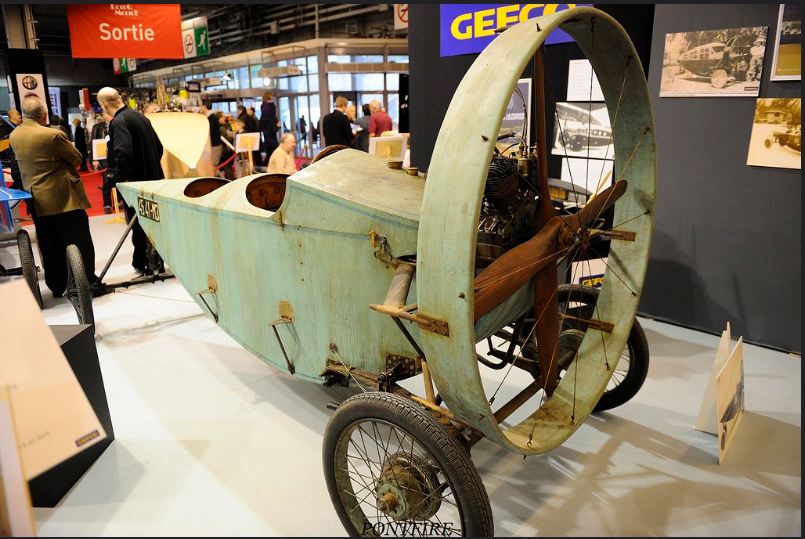 |
| Left: The Maratuech prop-car?: 1925
This prop-car was allegedly built by inventor Fernand Maratuech of Fumel, France. He was an agricultural mechanic, accordionist, champion cyclist, and triathlete.
However, there is a video of a restored car designed by Maratuech on YouTube and while it looks vaguely like an aeroplane it has no propellor, and is clearly not the same machine. The car in the picture here looks like a Helica to me.
|

THE MCLAUGHLIN PROP-CAR
 |
| Left: The McLaughlin prop-car: 1926
This image is another that appears repeatedly if you Google 'propeller-car', but once again information is in short supply. It was built by George McLaughlin in 1926. Apart from this image, he appears to be unknown to Google.
There was a McLaughlin motor car company, but no link has so far been established.
The engine appears to be a straight-6.
|

THE JAMESON PROP-CAR
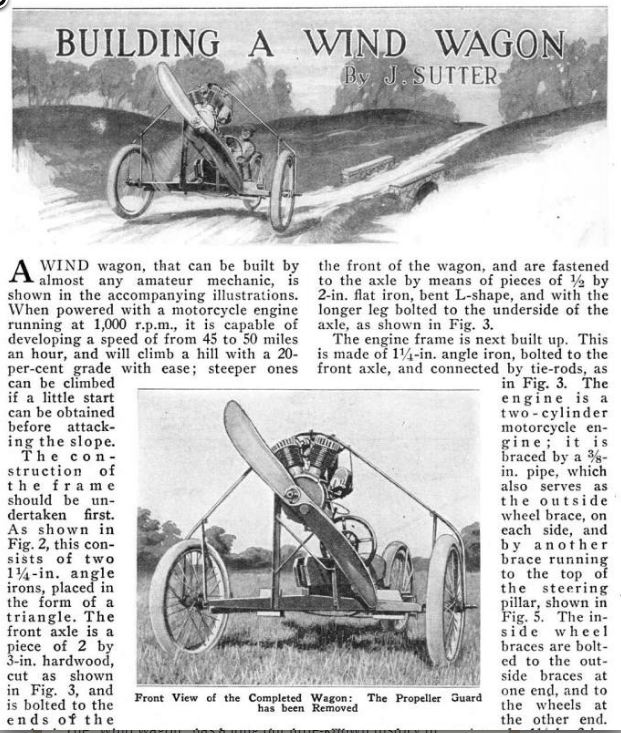 |
| Left: The Jameson prop-car: 1925
One volume of The Boy Mechanic, published in 1925 had an article titled “Building a Wind Wagon.”
This seems an awfully ambitious project for a 'boy'.
Source: The Boy Mechanic 1929 Book 4. The Boy Mechanic was series of books rather than a magazine.
|
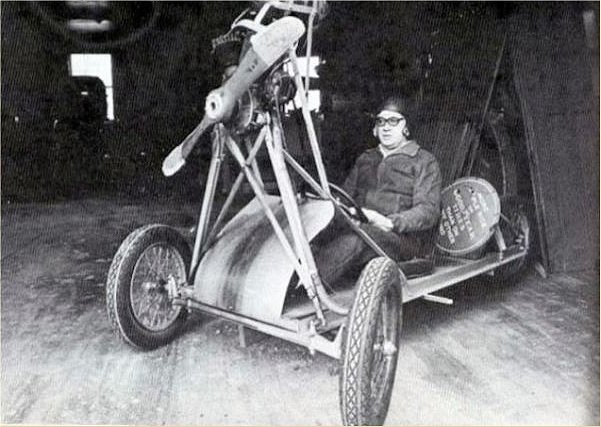 |
| Left: The Jameson prop-car: 1929
It is unknown how many were built but here is one version constructed in 1929 by 15-year-old Ted Jameson. This is a recent photograph, not from 1929. There are many minor differences between this machine and the one pictured above.
The angle-iron chassis carries a beam front axle, and has neither front nor rear suspension. The propeller is driven by a Harley-Davidson V-twin motorcycle engine.
It is reported that its acceleration and hill climbing abilities leave something to be desired. According to the Lane Motor Museum it works best on a frozen lake.
One wonders about the safety implications of encouraging boys to experiment with whirling propellors...
The machine is at the Lane Motor Museum at Nashville TN, USA.
https://www.lanemotormuseum.org/775-wingless-wonders
|
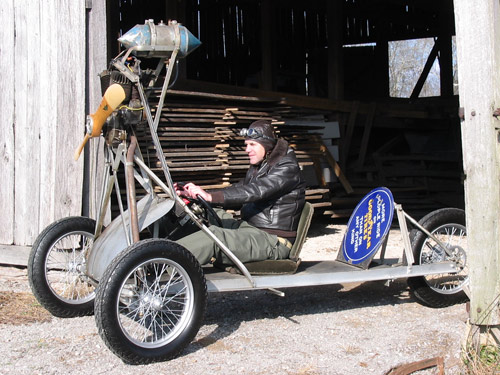 |
| Left: The Jameson prop-car: 1929
This was pretty obviously taken at the same time as the photo above, and gives much more information. There is a 'stream-lined' petrol tank mounted high in the air to allow gravity feed. By 1929 most people knew that sharp points at the front gave more drag than a domed nose.
The text on the round sign behind the driver is mostly illegible, but the largest text says 'Goodyear Tyres'.
|
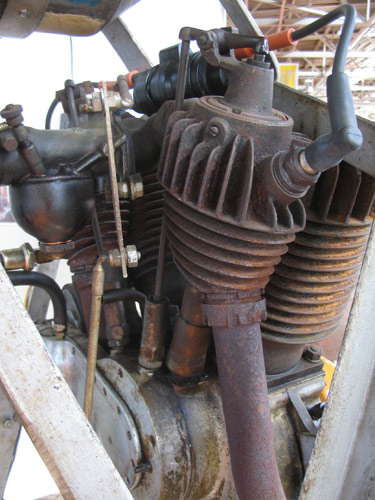 |
| Left: The Jameson prop-car engine: 1929
This is the engine, and it is rather puzzling. It seems to be a V-twin, but to the right there is a third larger cylinder. Possibly it was a pumping cylinder for 2-stroke operation? Note the mechanically-operated inlet valve in the cylinder head. According to Lane Motor Museum the engine is a Harley-Davidson V-twin, but if so what's the third cylinder about?
The propellor is attached at the left-hand side.
|

THE SOHN VANE CAR
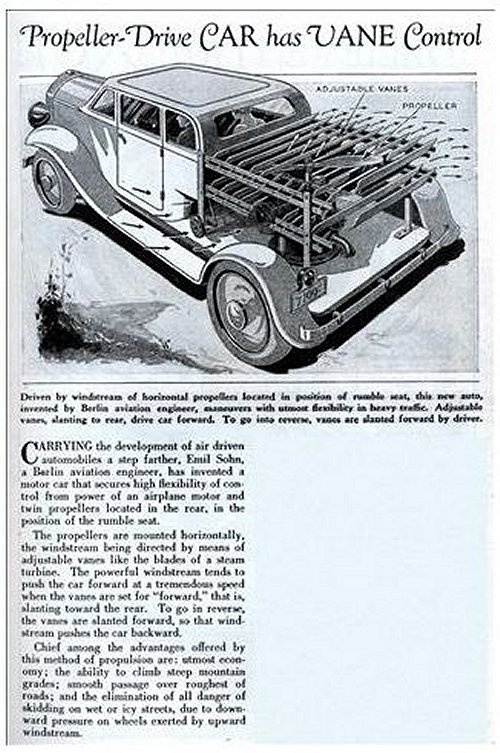 |
| Left: The Sohn vane-car: 1931
This car project was unusual even for prop-cars, as it had horizontal propellors that blew air upwards. Swivelling vanes then directed the air partly forward or partly backward, as desired. The obvious problem is that whatever the vane setting, a lot of the force is going to be directed downwards, and the arrangement must have been very inefficent even when compared to 'conventional' prop-cars. The article presents this as an advantage, as it gives more adhesion, but since the propulsion does not use tyre adhesion any advantage would be restricted to braking and rear-end handling.
It is notable that the article is illustrated with a drawing rather than a photograph, and it seems highly unlikely that a prototype was ever built.
It was all in vane.
Source: Modern Mechanix Sep, 1931
|

THE ADELE AIR -CAR
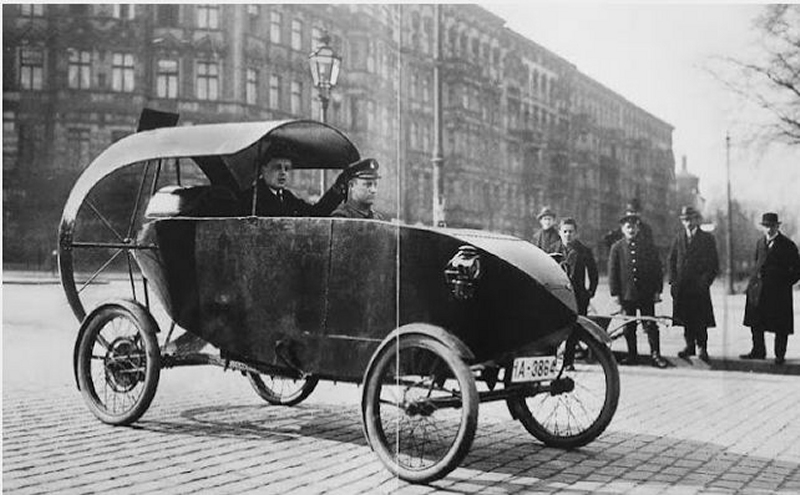 |
| Left: The Adele Aircar: 1922
The owner and chauffeur in the Adele Air Car in Germany. The IA license plate shows the car was registered in Berlin.
Note the very neat way that the propellor guard and roof are in one piece. No roof for the chauffeur...
Strangely no propellor is visible; perhaps it was turning.
Nothing is known to Google except the name and this photograph, which apparently is dated 19th May 1922.
|

THE JOE BAIRD WIND-WAGON
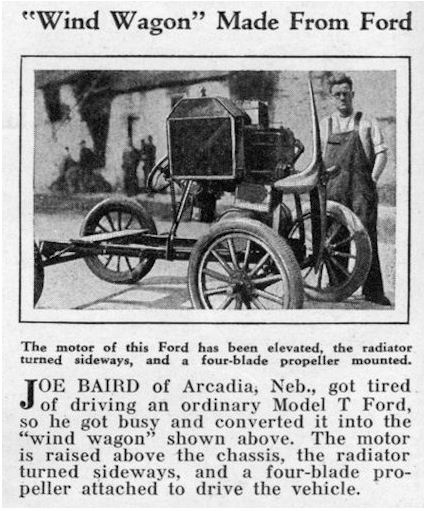 |
| Left: The Joe Baird Wind-Wagon: 1931
Note the radiator is mounted sideways.
Source: unknown, but clearly from Popular Mechanix or a similiar magazine. Date speculative
|
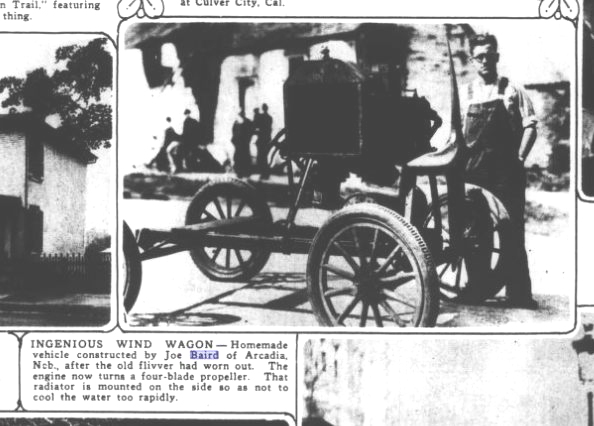 |
| Left: The Joe Baird Wind-Wagon: 1931
The same photograph but with a few more details. The year is now known to be 1931.
Source: The St. Louis Post-Dispatch, 4th October 1931
|

THE HELICRON
The Helicron prop-car was a later design. It was a one-off conversion from a Rosengart chassis, and was built in France in 1932
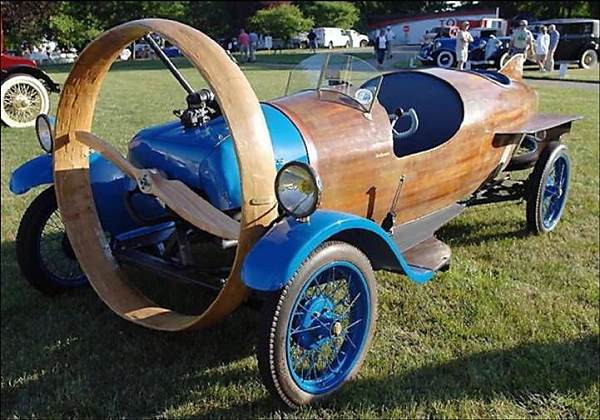 |
| Left: The only Helicron. It has rear-wheel steering, and only the rear wheels are sprung
The car was restored after being found in a barn in 2000. The original engine was lost and has been replaced by a flat-four Citroen GS engine. An idea that a true Parts Geek with experience in car maintenance or restoration can certainly appreciate.
The car has allegedly passed a French safety inspection and is legal for use on public roads. Given that barely-guarded propellor, I find that very surprising. As one unconvinced commentator put it: "Leave it up to the French to design a car where the express purpose seems to be mowing down snivelling pedestrians for the sake of style."
The Helicron these days resides at the Lane Motor Museum in Nashville, Tenessee, and it is drivable. The Helicron appears in the video from 11:54 to 14:54. The Museum say that the car was based on an Austin 7 chassis. Many more photographs of this car can be found by Googling "Helicron".
|

THE PONDER PROP-CAR
 |
| Left: The Ponder prop-car: 1934
None of your mollycoddlng nonsense about guarding the propellor here.
I have grave doubts if 85 mph was actually obtained, but at least there is no doubt that it was actually built.
This image from Modern Mechanix, Nov 1934
|


JUERGENS PROPCAR
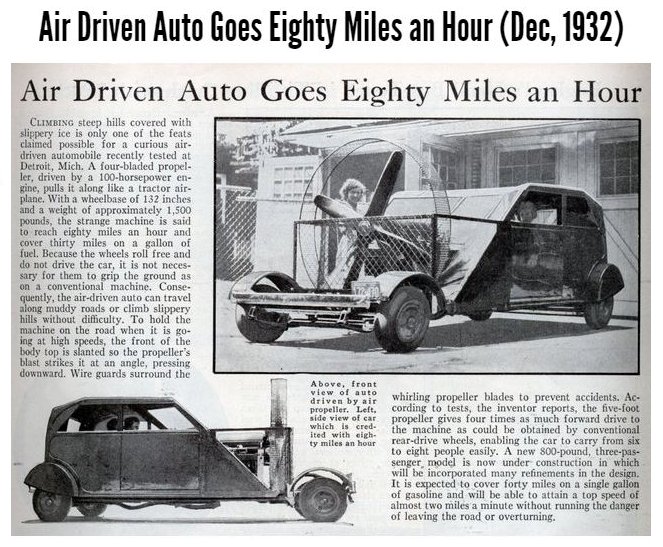 |
| Left: The Juergens propcar: 1936
This one-off prop-car was tested in Detroit, with a hefty 100 HP engine driving the prop. Note that all the performance claims are 'expected', so the testing can't have been very thorough at this point. As usual there are quite unrealistic claims made for speed and economy. In particular I don't believe that the propellor provided four times the "forward drive" of a conventional rear axle.
There is also the usual claim that the machine is great for moving through mud or snow, but this overlooks the fact that having some steering and braking capability would be rather desirable.
The idea of obtaining downforce by sloping the front is ingenious, but it is not mentioned in the patent; the sloping front was intended to reduce wind-resistance.
Note that a new version is planned which 'will be able to attain a top speed of almost two miles a minute without leaving the road or overturning', which is typical of the wild claims made for unconventional cars. I am much reassured about not overturning at 120 mph...
Source: Popular Science, Dec 1932
|
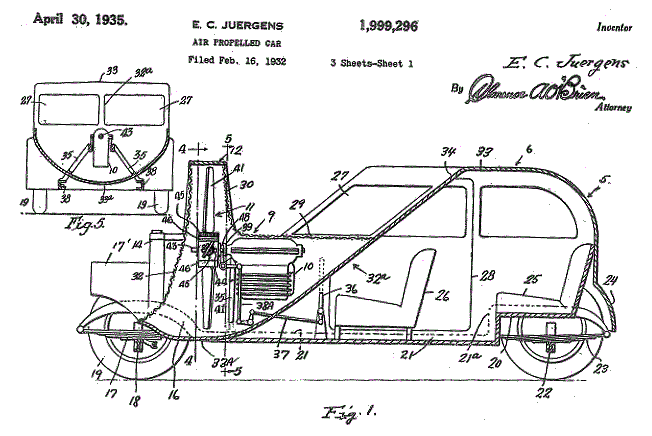 |
| Left: The Juergens propcar patent: 1936
The engine 10 was a four-cylinder inverted type, as often used in aeroplanes as it gave a better forward view.
|

THE SCHLÖRWAGEN PROP-CAR
 |
| Left: The Schlörwagen prop-car: 1936
The Schlörwagen Pillbug was a prototype highly-aerodynamic rear-engined car developed by German engineer Karl Schlör (1911–1997) in 1936. In English a pillbug is basically a woodlouse, which has a similiar body shape. There is a Wikipedia page.
Initial wind tunnel tests on the unengined body gave an extraordinarily low drag coefficient (Cd) of 0.113. It was then fitted with a conventional rear engine, which degraded the Cd slightly, probably because of shape changes at the rear to accomodate the engine. It was exhibited at the 1939 Berlin Auto Show. The design had stability issues with crosswinds probably due to the engine position which was well behind the rear wheels. The project was shelved with the onset of WW2.
In 1942, the Schlörwagen prototype had somehow gotten into Russian hands; it was fitted with an Soviet radial air-cooled aero-engine which appears to have developed 100 or 125 hp, driving a ducted fan. Several references say it was a five-cylinder engine, but in this view three or four cylinders are visible, which suggests it was actually a seven-cylinder engine.
Why this conversion was made is unknown, but the Russians have always been keen to put propellors on things, including sledges.
It certainly makes most of the other prop-cars look very amateur.
|
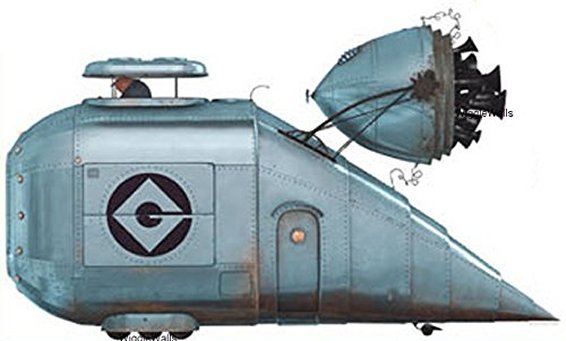 |
| Left: The Gru vehicle: 2010
It took me a little while to work out what the Schlörwagen reminded me of; Gru's car/plane/whatever from Despicable Me.
|
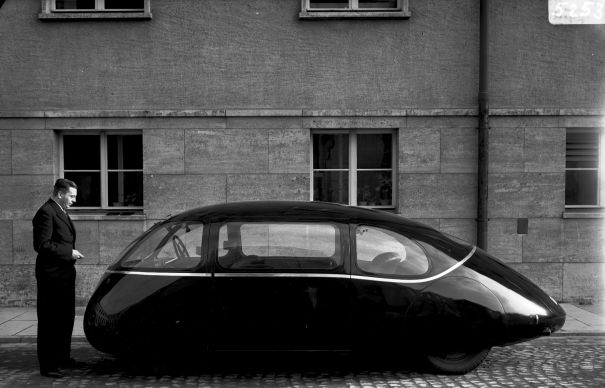 |
| Left: The Schlörwagen prop-car: 1936
Here is the Schlörwagen in the first phase of its career, without a propellor.
|
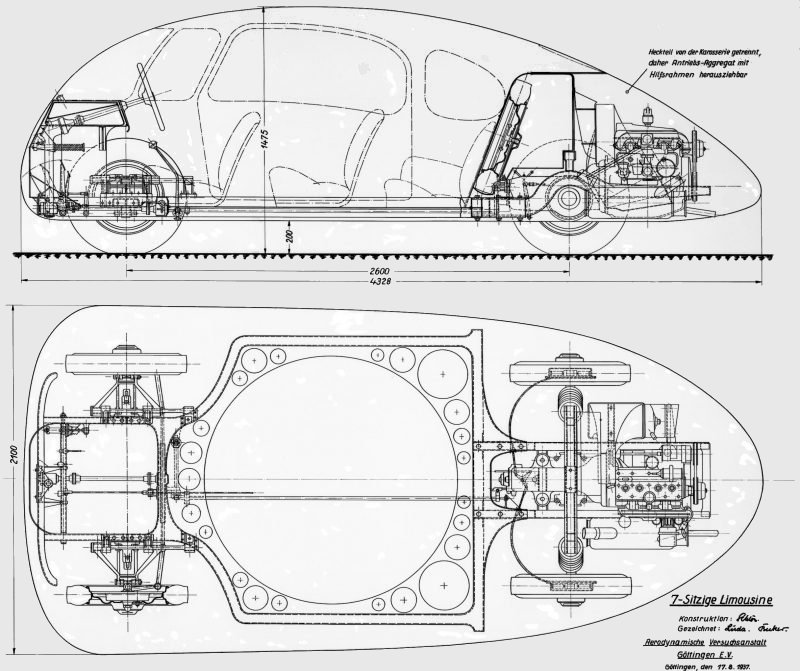 |
| Left: The Schlörwagen prop-car: 1936
These drawings of the original non-prop Schlörwagen show it was a seven-seater; the driver sat centrally at the front.
Note how the engine is mounted well behind the back axle.
|
 |
| Left: The Schlörwagen prop-car: 1936
The central driver's position, between the two front wheel-arches. These are large as they need to give room for steering movements of the wheels.
|


UNKNOWN PROP-CAR ON YOUTUBE
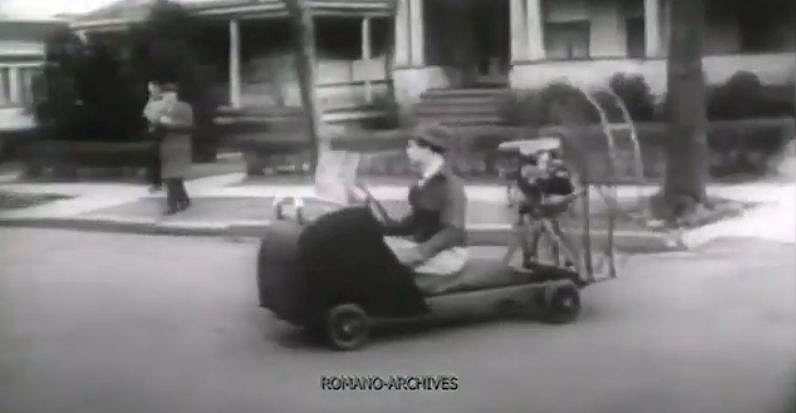 |
| Left: Unknown propcar on YouTube: 19446
A video on YouTube shows a small prop-car with a flat-twin engine and a two-blade prop. It appears from 0:54 to 1:15 in the video.
Nothing else known.
|


THE MAYBACH PROP-CAR
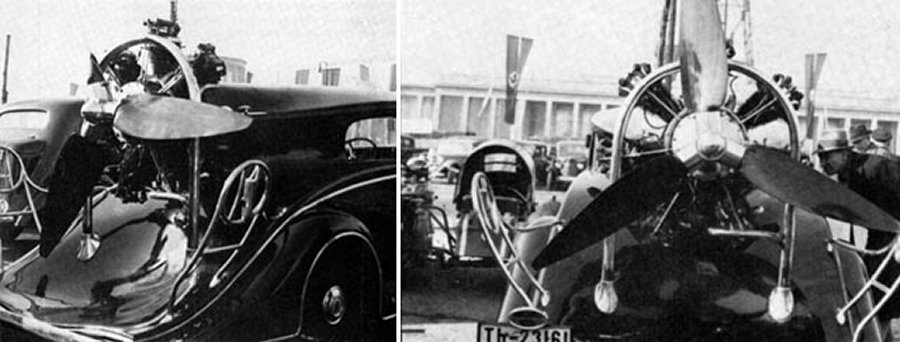 |
| Left: The Maybach prop-car: 1938
This German design was a bit more sophisticated than your average prop-car. The Maybach had a seven cylinder radial engine and a three-blade variable pitch propellor; the latter should have done something to improve the otherwise dire low-speed acceleration, but no accounts of its operation have been found so far.
The vestigial propellor-guards on each side are not very reassuring.
The purpose of this project is currently unknown. It might have been intended as an army staff car to deal with difficult ground conditions like ice and snow.
The body is believed to have been made by Spohn, who had frequently collaborated with Maybach on streamline designs.
|
 |
| Left: The Maybach prop-car: 1938
For some reason this picture is much rarer than the two above. Possibly because these two lads are in the uniform of the Hitlerjugend.
|


THE CLIFFORD ROBBINS PROP-CAR
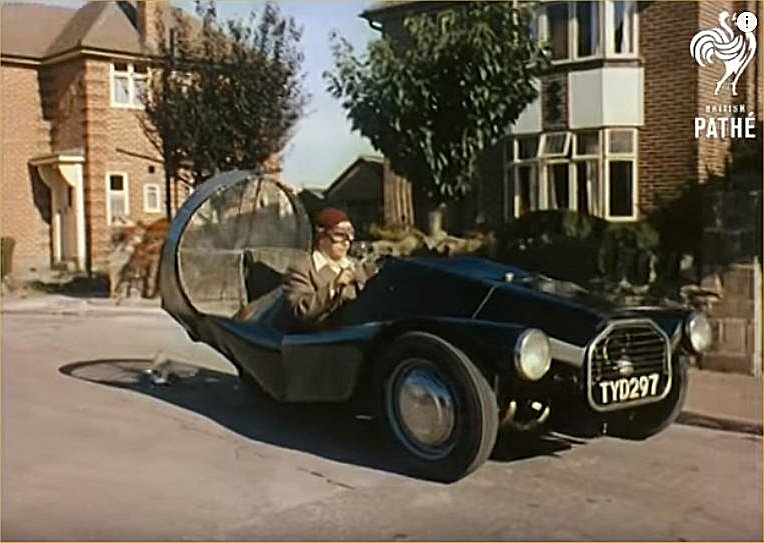 |
| Left: The Robbins prop-car: 1955
This three-wheeled prop-car was built by 32-year-old Clifford Robbins of Yeovil, Somerset. The propellor was 3 feet in diameter, and the engine was a 15 HP V4 which was allegedly obtained by cutting a Ford V8 in half. (Is that possible?) It is said to have cost £200 to build, and six months work. The builder claimed a top speed of 70 mph and a fuel consumption of 60 mpg.
There is a British Pathe newsreel on YouTube of TYD 297, made (in colour) in 1955. Clifford Robbins is in various sources described as a grocer or a 'professional confectioner'.
You will note that early on in the video, at around 0:17, the prop-car is overtaken with ease by two ordinary cars and a van.
|
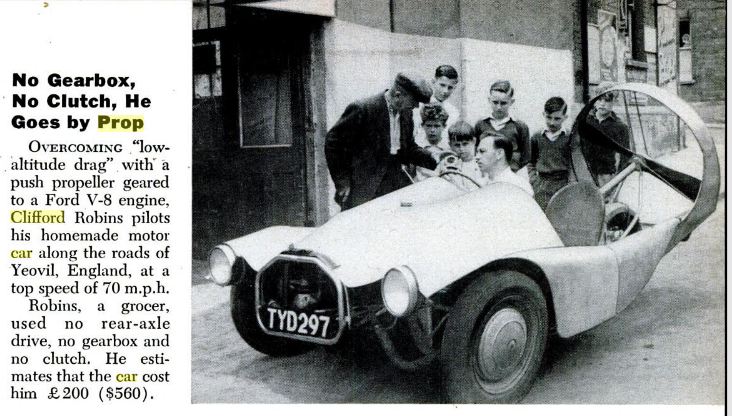 |
| Left: The Robbins prop-car: 1955
This image from Popular Science, Jan 1956
|

THE ARGENTINE AEROCAR
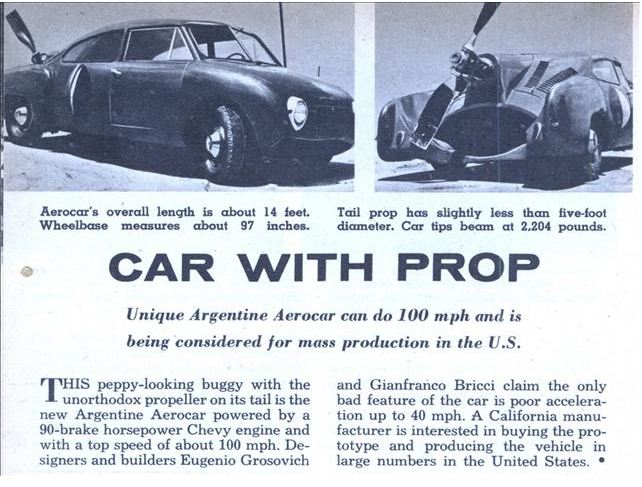 |
| Left: The Argentine Aerocar: 1955
There seems to be no hint of a propellor guard. Needless to say, large numbers were not produced in the USA.
This prop-car was built by Eugenio Grosovich and Gianfranco Bricci. It appears to have been built from scratch rather than by modification of a conventional car.
It was equipped with a Chevrolet straight-six engine of 90 HP mounted above the rear axle; this appears to have been conventionally water-cooled though it is not clear where the radiator was mounted. Power was routed to the propeller through six parallel belts of trapezoidal section. The two-bladed propeller had an angle of attack of 9 degrees (? This is a Google translation from Spanish) and was of five feet diameter; as the blade shape suggests, it was cut down from a larger original.
As with all prop-cars, acceleration from rest was poor, and it took a long time to reach 60 km/h but after that accelerated much more rapidly to 160 km/h.
This image from Mechanix Illustrated for October 1955
|
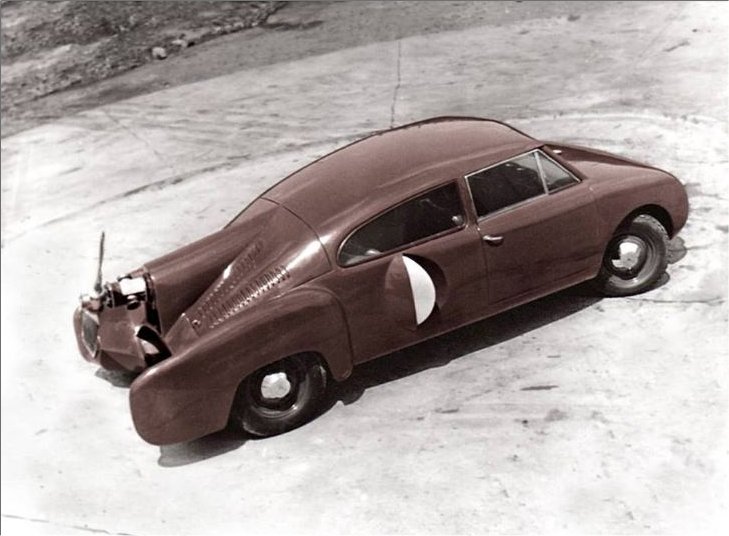 |
| Left: The Argentine Aerocar: 1955
The Aerocar looks a rather neat bit of design. (If we overlook the whole propellor business)
At some point in its career it gained a guard around the propellor.
It was eventually converted to a conventional transmission system; its current whereabouts are unknown.
|

BRAZILIAN PROP-CAR
 |
| Left: The FE1 X1: 1968
This remarkable prop-car was constructed at the Centro Universitario da Fei in Brazil. This car is not only prop-driven, but is also allegedly amphibous. There is a YouTube video of the car on display.
There is also YouTube video of the car in motion. (starts at 1:04) It is a touch on the dubious side because in many of the sequences the car is moving along with the propellor stationary or barely moving. Probably it is running downhill... There are no scenes of it afloat.
The rear-mounted Gordini engine was a 4-cylinder water-cooled unit of 848 cc, with a power output of 40 HP, driving the propellor by belt, with a reduction ratio of about 2:1. Claimed top speeds: 150 km/h (93 mph)on road, 20 km/h(12 mph) on water.
|
The car appears to have three wheels but actually there are two very small wheels at the front, on a very short axle; they appear to have solid tyres. This axle is swivelled by a tiller for steering. It looks more like something on a shopping trolley rather than a serious suspension system and it is in no way suitable for travelling at 93 mph.
Car dimensions: Length 3820 mm. Width 1480 mm. Height 1400 mm. Wheelbase 2000 mm. Weight: 400 kg.
The car was exhibited in 1968 at a show in Sao Paulo, Brazil.

THE BRUDER WIND WAGON: 2001
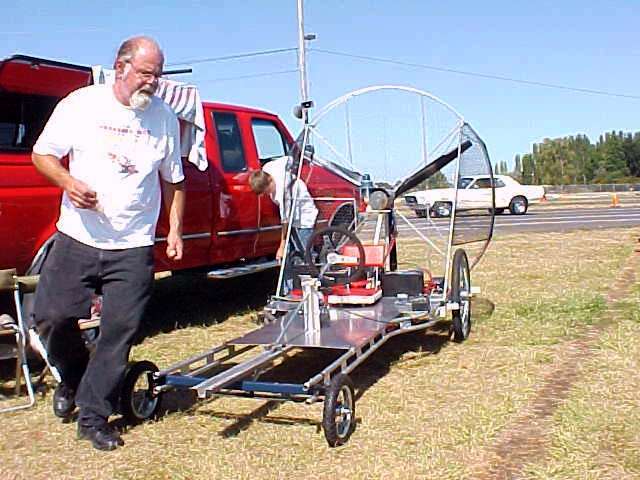 |
| Left: The Bruder Wind Wagon: 2001
This is so far the only propcar not to be powered by an IC engine. The prop is driven by 24 Volt DC
2 HP electric motor.
There is more information here.
Note that people are still using the phrase 'Wind-Wagon' after 100 years. Alliteration is a powerful thing.
|

THE STUTTGART VENTOMOBILE: 2008
 |
| Left: The Stuttgart Ventomobile: 2008
And now for something rather different. It is propelled by moving air, in a sort of backwards way. The big propellor is actually a wind turbine, which extracts power from the wind and thus drives the rear wheels.
At the Aeolus Race in the Dutch town of Den Helder in 2008 five universities and research centres competed to show the best wind-powered car. In this first time ever race the participating teams were challenged to drive directly into the wind, without tacking. The Ventomobile had already proven to be the lightest at 130 kg and most efficient vehicle among the entrants when it raced at 64% of the wind speed, directly against the wind. It was built by Alexander Miller and Jan Lehmann, with help from Stuttgart University Department of Composites and Lightweight Construction.
There is more information here. And Bristol University is also involved.
|

THE ERICKSON BEETLEFAN: 20??
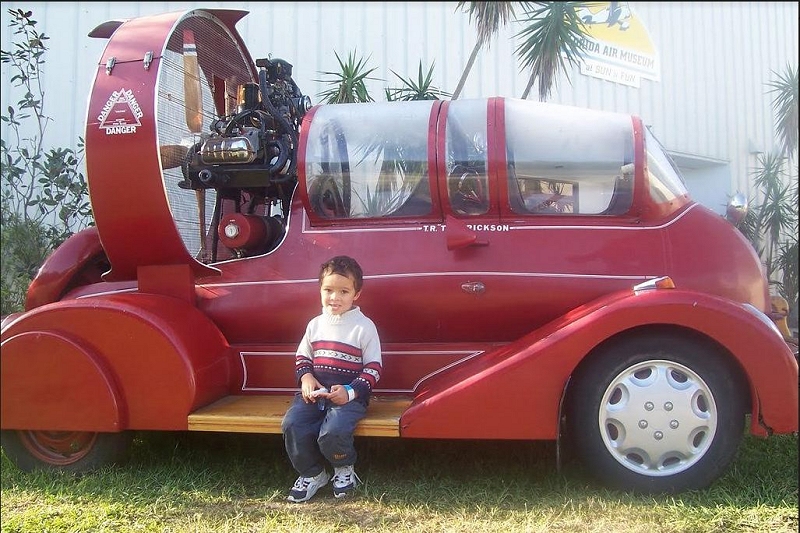 |
| Left: The Erickson Beetlefan: 20??
Not much is known about this very tidy bit of work. It appears to be called a Beetlefan, though the bodywork does not much resemble a VW Beetle. The engine however does look like it might be a flat-four air-cooled VW engine. As propellor-driven cars go, it looks fairly practical. Note four-blade proplellor.
It is a single-seater.
T R T?? Erickson is written on the side of the car, so presumably he built it. Googling has yielded nothing.
Do not do an image search as it leads to bad places.
|
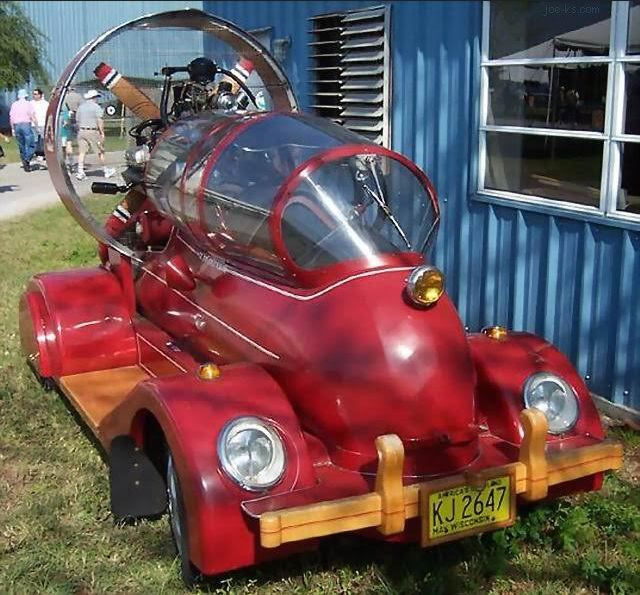 |
| Left: The Erickson Beetlefan: 20??
The number plate shows the vehicle is registered in Wisconsin and is presumably street-legal.
|

THE LANE MOTOR MUSEUM PROPCAR GALLERY
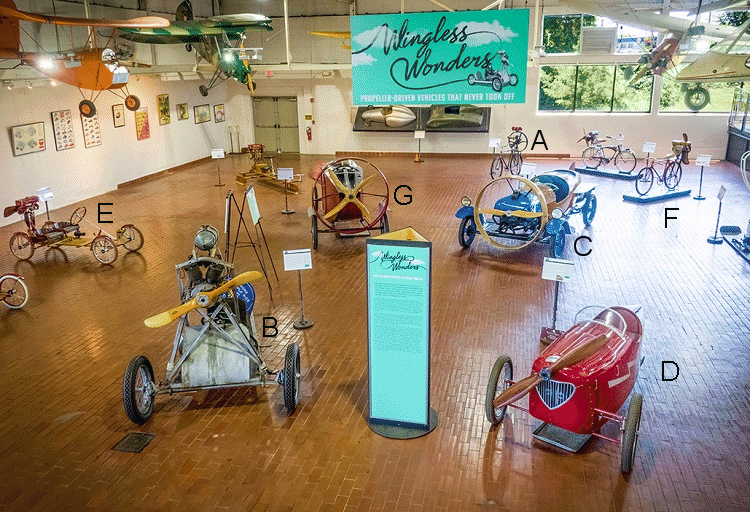 |
| Left: The Lane Motor Museum propcar gallery: 2022
The Lane Motor Museum gallery includes propcars, (3 wheels or more) propbikes, and prop-motorcycles; the line between the last two categories is blurred. There are a few aeroplanes as well, hanging from the roof. Those vehicles which have been identified are listed below. Note that some of these are not on this page as yet:
- A: Peugeot propellor bicycle: 1920s. See here
- B: The Jameson prop-car: 1929. See here
- C: Helicron from France:1932. See here
- D: L'Eclair from France: 1930. .
- E: Smith Flyer Replica with Aerothrust engine: 1915. .
- F: Klinedinst racing bike with Aerothrust Propeller: 1914. .
- G: Leyat Helica from France: 1919. See here..
Thanks to Paul Dunlop for help with identifications
|




































































































